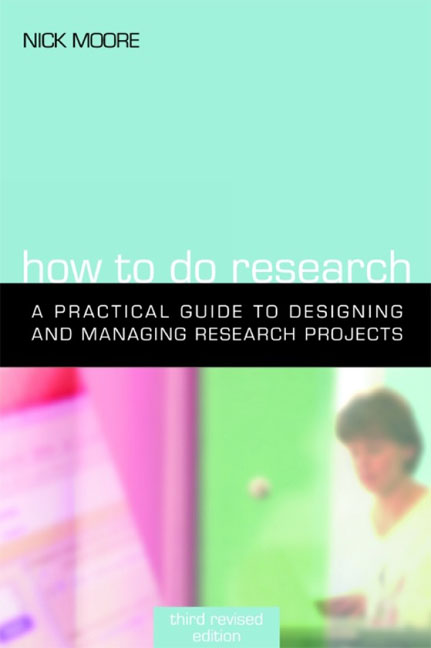Book contents
- Frontmatter
- Contents
- Acknowledgements
- Introduction: Types of research
- Part 1 The research process
- 1 Develop the research objectives
- 2 Design and plan the study
- 3 Write the proposal
- 4 Obtain financial support for the research
- 5 Manage the research
- 6 Draw conclusions and make recommendations
- 7 Write the report
- 8 Disseminate the results
- Part 2 Methods
- Appendix The market for information professionals: A proposal from the Policy Studies Institute
- Index
1 - Develop the research objectives
from Part 1 - The research process
Published online by Cambridge University Press: 09 June 2018
- Frontmatter
- Contents
- Acknowledgements
- Introduction: Types of research
- Part 1 The research process
- 1 Develop the research objectives
- 2 Design and plan the study
- 3 Write the proposal
- 4 Obtain financial support for the research
- 5 Manage the research
- 6 Draw conclusions and make recommendations
- 7 Write the report
- 8 Disseminate the results
- Part 2 Methods
- Appendix The market for information professionals: A proposal from the Policy Studies Institute
- Index
Summary
The importance of research aims and objectives cannot be over-stressed. It is vital to have a very clear understanding of what the research is about and what you are actually trying to achieve. You need to know this. And you need to be able to communicate it to others.
Carrying out a research project is rather like going on a journey. It is a linear process during which, in theory at least, you move from your starting point to your objective and then tell others the story of your journey. In practice it can become much more complex.
Once begun, there are few opportunities to retrace your steps if you get lost or side-tracked. The project develops a momentum of its own and it is often difficult to slow things down or to alter course. There are also lots of fascinating by-ways and side routes that might be interesting to explore. This is made worse by the fact that as the research – or the journey – progresses, the level of complexity increases and it is easy to find yourself in the middle of a metaphorical forest with many paths leading in different directions and no clear indication of which is the best one to take.
Assuming that you manage to find your way through all this, you still need to retain a clear idea about where you are going so that you know when you have reached your destination.
A clear, unambiguous research aim coupled with a precise statement of research objectives will provide you with an initial sense of direction. It will enable you to design the research project, selecting the most appropriate methods. It will also provide the basis for managing the research once the project is underway. It will also be an invaluable guide when it comes to analysing the results and making sense of it all.
A clear idea of what you are going to do is also an essential part of obtaining support from others, whether they be stakeholders, potential funders or subjects of the research.
Information
- Type
- Chapter
- Information
- How to Do ResearchA practical guide to designing and managing research projects, pp. 3 - 9Publisher: FacetPrint publication year: 2006
